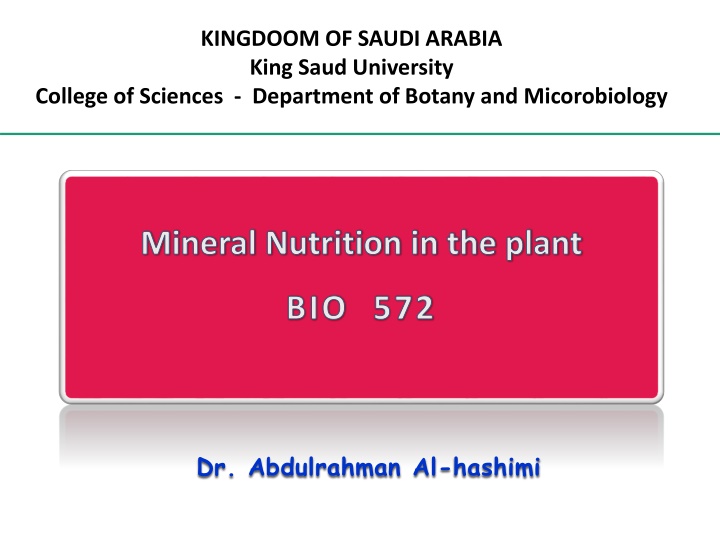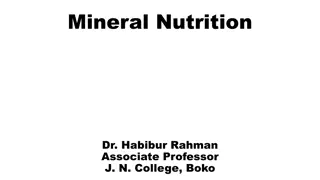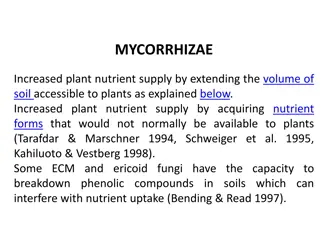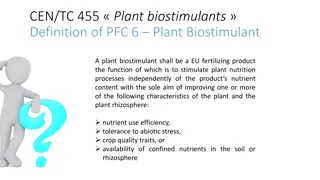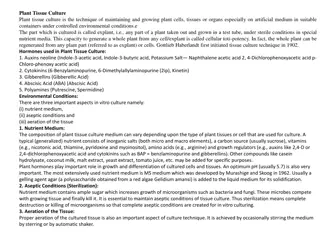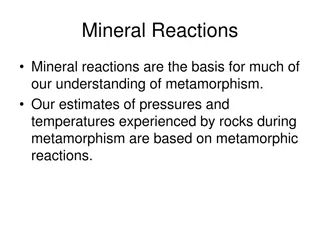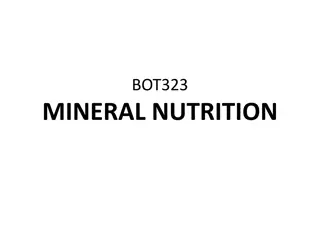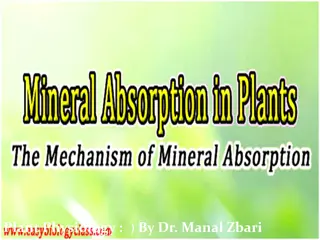Plant Nutrient Assimilation: Understanding Mineral Nutrition
Higher plants use inorganic nutrients from the soil for growth and development through a process called Nutrient Assimilation. This involves incorporating mineral nutrients into essential organic compounds like pigments, enzymes, lipids, nucleic acids, and amino acids. The assimilation of nitrogen and sulfur, among other nutrients, requires complex biochemical reactions, while the formation of complexes with organic compounds is crucial for macronutrient and micronutrient cations. Explore the vital processes of mineral nutrition in plants at King Saud University.
Download Presentation

Please find below an Image/Link to download the presentation.
The content on the website is provided AS IS for your information and personal use only. It may not be sold, licensed, or shared on other websites without obtaining consent from the author.If you encounter any issues during the download, it is possible that the publisher has removed the file from their server.
You are allowed to download the files provided on this website for personal or commercial use, subject to the condition that they are used lawfully. All files are the property of their respective owners.
The content on the website is provided AS IS for your information and personal use only. It may not be sold, licensed, or shared on other websites without obtaining consent from the author.
E N D
Presentation Transcript
KINGDOOM OF SAUDI ARABIA King Saud University College of Sciences - Department of Botany and Micorobiology Mineral Nutrition in the plant BIO 572 Dr. Abdulrahman Al-hashimi
Assimilation of Mineral Nutrients Nitrate assimilation Ammonium assimilation Biological nitrogen fixation Sulfur assimilation Phosphate assimilation Cation assimilation Oxygen assimilation
Introduction Higher plants are autotrophic organisms that can synthesize their organic molecular components from inorganic nutrients obtained from their surroundings. For many mineral nutrients, this process involves absorption from the soil by the roots and incorporation into the organic compounds that are essential for growth and development. This incorporation of mineral nutrients into organic substances such as pigments, enzyme cofactors, lipids, nucleic acids, and amino acids is termed Nutrient Assimilation.
Introduction Assimilation of some nutrients, particularly nitrogen and sulfur, requires a complex series of biochemical reactions that are among the most energy-requiring reactions. Assimilation of other nutrients, especially the macronutrient and micronutrient cations, involves the formation of complexes with organic compounds. For example, Mg2+ associates with chlorophyll pigments These complexes are highly stable, and removal of the nutrient from the complex may result in total loss of function.
Nitrogen in the environment Present in many forms : 78% of atmosphere is N2 gas. Most of this is NOT available to living organisms. Getting N2 form the atmosphere requires breaking the triple bond between N2 gas to produce: Ammonia (NH3) Nitrate (NO3-) These reactions, known as nitrogen fixation.
Nitrogen fixation Nitrogen fixation can be achieved by both industrial and natural processes. Nitrogen fixation by industrial processes : Under high temperature (about 200 C) and high pressure (200 atmospheres), N2 combines with hydrogen to form ammonia. This nitrogen fixation reaction, known as Haber Bosch process, is an artificial nitrogen fixation process and is the main industrial procedure for the production of ammonia.
Nitrogen fixation Nitrogen fixation by natural processes include : 1. Lightning: Lightning is responsible for about 8% of the nitrogen fixed. Lightning converts water vapor (H2O) and oxygen (O2) into free hydrogen atoms (H), and free oxygen atoms (O) that attack the nitrogen (N2) to form nitric acid (HNO3). This nitric acid subsequently falls to Earth with rain.
Nitrogen fixation 2. Photochemical reactions: Approximately 2% of the nitrogen fixed derives from photochemical reactions between the nitric oxide gas (NO) and ozone (O3) that produce nitric acid (HNO3). 3. Biological nitrogen fixation: The remaining 90% results from biological nitrogen fixation, in which bacteria or blue-green algae (cyanobacteria) fix N2 into ammonium (NH4+).
Nitrogen fixation Once fixed in ammonium or nitrate : N2 enters biochemical cycle, Passes through several organic or inorganic forms before it returns to molecular nitrogen, The ammonium (NH4+) and nitrate (NO3-) ions generated via fixation are the object of strong competition between plants and microorganisms To remain competitive, plants have developed mechanisms to get these ions from the soil solution as fast as possible.
Nitrate assimilation Plants assimilate most of the nitrate absorbed by their roots into organic nitrogen compounds. The first step of the process is the reduction of nitrate (NO3-) to nitrite(NO2-) in the cytosol by nitrate reductase enzyme. The nitrite (NO2-) is a highly reactive and potentially toxic ion. Plant cells immediately transport the nitrite from the cytosol into chloroplasts in leaves and plastids in roots. In these organelles, the enzyme nitrite reductase reduces the nitrite (NO2-) to ammonium (NH4+).
Ammonium assimilation High levels of ammonium are toxic, thus, the plant cells avoid the ammonium toxicity by rapidly converting the ammonium generated from nitrate assimilation into amino acids. This requires the action of two enzymes ; 1. Glutamine synthetase, combines the ammonium with glutamate to form glutamine. 2. Glutamate synthase, transfers the amino group of glutamine to an intermediate, yielding two molecules of glutamate.
Ammonium assimilation Structure and pathways of compounds involved in ammonium metabolism
Ammonium assimilation Ammonium can be assimilated via an alternative pathway (using the enzyme Glutamate dehydrogenase)
Transamination reactions Once assimilated into glutamine and glutamate, nitrogen is incorporated into other amino acids via transamination reactions. The enzymes involved in these reactions are known as aminotransferases (for example, aspartate aminotransferase). All transamination reactions require pyridoxal phosphate (vitamin B6) as a cofactor. Aminotransferases are found in the cytoplasm, chloroplasts, mitochondria, glyoxysomes, and peroxisomes.
Transamination reactions An example of aminotransferase
Biological nitrogen fixation Biological nitrogen fixation accounts for most of the fixation of atmospheric N2 into ammonium. Two major types of nitrogen fixation : Prokaryotes that are free-living in soil, lake, and ocean. Symbiotic bacteria. Most of nitrogen-fixing prokaryotes are free living in the soil. A few of them form symbiotic associations with higher plants, where the prokaryote directly provides the host plant with fixed nitrogen in exchange for other nutrients and carbohydrates.
Biological nitrogen fixation The most common type of symbiosis occurs between members of the plant family Leguminosae and soil bacteria of the genera Azorhizobium, Bradyrhizobium, Photorhizobium, Rhizobium, and Sinorhizobium (collectively called rhizobia). Nitrogen fixation requires anaerobic conditions, Therefore each of the nitrogen-fixing organisms either functions under natural anaerobic conditions or can create an internal anaerobic environment in the presence of oxygen. In cyanobacteria, anaerobic conditions are created in specialized cells called heterocysts.
Biological nitrogen fixation Examples of organisms that can fix nitrogen
Biological nitrogen fixation Examples of organisms that can fix nitrogen (Non-symbiotic N2 fixation)
Biological nitrogen fixation Symbiotic N2 fixation : 1. Rhizobia Legume Unicellular Rhizobial symbiosis 2. Actinomycetes Nonleguminous plants Filamentous bacteria Live freely in soil, but fix nitrogen in symbiotic association with host. Actinorhizal symbiosis
Biological nitrogen fixation Non-symbiotic N2 fixation : 1. Cyanobacteria (Blue-green algae) 2. Other bacteria : Aerobic : Azotobacter, Beijerinckia, Derxia, etc. Facultative : Bacillus, Klebsiella, etc. Anaerobic : Non-photosynthetic : Clostridium, Methanococcus Photosynthetic : Rhodospirillum, Chromatium
Biological nitrogen fixation Symbiotic N2 Fixation occurs in specialized structures Symbiotic nitrogen-fixing prokaryotes live within nodules, the nodules arespecial organs of the plant host that enclose the nitrogen-fixing bacteria. In the case of legumes and actinorhizal plants, the nitrogen- fixing bacteria induce the plant to form root nodules. Vascular connections between the host and microorganism provide the exchange of carbon and nitrogen.
Biological nitrogen fixation Both legumes and actinorhizal plants regulate gas permeability in their root nodules, for maintaining a level of oxygen within the nodule that can support cellular respiration for the bacteria. The nodules ; Contain an oxygen binding heme protein (leghemoglobin) Leghemoglobin produces a pink color and helps transport oxygen to the respiring symbiotic bacteria cells in a manner analogous to hemoglobin transporting oxygen to respiring tissues in animals.
Biological nitrogen fixation Grasses can also develop symbiotic relationships with nitrogen-fixing organisms, but these associations do not lead to the formation of root nodules Nitrogen-fixing bacteria seem to colonize plant tissues or anchor to the root surface, mainly around the elongation zone and the root hairs. Known as actinorhizal plants.
Biological nitrogen fixation Root nodules on soybean
Biological nitrogen fixation Symbiosis The symbiosis between legumes and the rhizobia is not obligatory. Legumes seedlings germinate without any association to the rhizobia, Rhizobia also occur as free-living organisms in the soil. Under nitrogen limiting conditions, the plant and bacteria seek each other out by an elaborate exchange of signals.
Biological nitrogen fixation Plant genes specific to nodules are called nodulin (nod) genes. Rhizobial genes that participate in nodule formation are called nodulation (nod) genes The nod genes are classified as : 1. Common nod genes : nodA, nodB, and nodC , found in all rhizobial strains 2. Host specific non genes : nodP, nodQ, nodH, nodE, and nodF , differ among rhizobial species and determine the host range.
Biological nitrogen fixation Nodule formation The first stage of the association is the migration of the bacteria through the soil towards the host plant. During root nodule formation, two process occur simultaneously; Infection and NoduleOrganogenesis.
Biological nitrogen fixation Nodule formation A. Rhizobia attach to the root hairs and release nod factors that produce a pronounced curling of the root hair cell. B. Rhizobia get caught and curl, degrade the root hair cell wall allowing the bacterial cells direct access to the outer surface of the plant plasma membrane.
Biological nitrogen fixation Nodule formation C. Golgi depositing material at the tip at the site of infection. Local degradation of root hair cell wall also occurs. D. Infection thread reaches end of the cell, and thread plasma membrane fuses with plasma membrane of root hair cell, bacterial cells are then released into fused plasma membranes.
Biological nitrogen fixation Nodule formation E. Rhizobia are released into the apoplast and enter the middle lamella, This leads to the formation of a new infection thread, which forms an open channel with the first F. Infection thread expands and branches until it reaches target cells, Vesicles composed of plant membrane enclose bacterial cells and they are released into the cytoplasm.
Biological nitrogen fixation Nitrogen fixation by the nitrogenase enzyme complex Biological nitrogen fixation, like industrial nitrogen fixation, produces ammonia from molecular nitrogen. The nitrogenase enzyme complex catalyzes this reaction. Only prokaryotes have this enzyme. Because the oxygen inactivates the nitrogenase enzymes, the nitrogen must be fixed under anaerobic conditions. N2 + 8H+ + 16ATP -----------> 2NH3 + H2 + 16ADP + 16Pi Nitrogenase
Sulfur assimilation Importance of sulfur in cells 1. Confer disulfide bridge in proteins. 2. Participate in Fe-S clusters for electron transport. 3. Several enzymes need sulfur. 4. Some secondary metabolites contain sulfur.
Sulfur assimilation Most of the sulfur in higher plants derives from sulfate (SO4-2) absorbed from the soil solution via an H+-SO4-2 symporter. The first step in the synthesis of sulfur-containing organic compounds is the reduction of sulfate to cysteine. The enzymes involved in cysteine synthesis have been found in the cytosol, plastids and mitochondria. Sulfate assimilation occurs mainly in leaves. Sulfur assimilated in leaves is exported as glutathione via the phloem to sites of protein synthesis.
Phosphate assimilation Plant roots absorb phosphate (H2PO4-) via H+-H2PO4- symporter from the soil. The main entry of phosphate into assimilatory pathway is ATP. The phosphate is subsequently incorporated into a variety of organic compounds, including ; 1. sugar phosphates 2. Phospholipids 3. nucleotides.
Cation assimilation Plants assimilate macronutrient cations (P, Mg, and Ca) and micronutrient cations (Cu, Fe, Mn, Co, Na, and Zn). Cations taken up by plant cells form complexes with organic compounds. Cations form coordination bonds and electrostatic bonds with carbon compounds. Most of the iron in the plant is found in the heme molecule of cytochromes within the chloroplasts and mitochondria. In addition, iron also exists in iron-sulfur proteins (ferredoxin).
Oxygen assimilation Respiration accounts for the bulk (about 90%) of the oxygen (O2) assimilated by plant cells. Another major pathway for the assimilation of O2 into organic compounds involves the incorporation of O2 from water. A small proportion of oxygen can be directly assimilated into organic compounds in the process of oxygen fixation. In oxygen fixation, molecular oxygen is added directly to an organic compound in reactions by the enzymes oxygenases.
The energetics of nutrient assimilation Nutrient assimilation generally requires large amounts of energy to convert stable, low-energy inorganic compounds into high- energy organic compounds. A plant may use 25% of its energy to assimilate nitrogen. Many of assimilatory reactions occur in stroma of chloroplasts, Plants use energy from photosynthesis to assimilate inorganic compounds in a process called photoassimilation.
Any QUESTIONS ?
